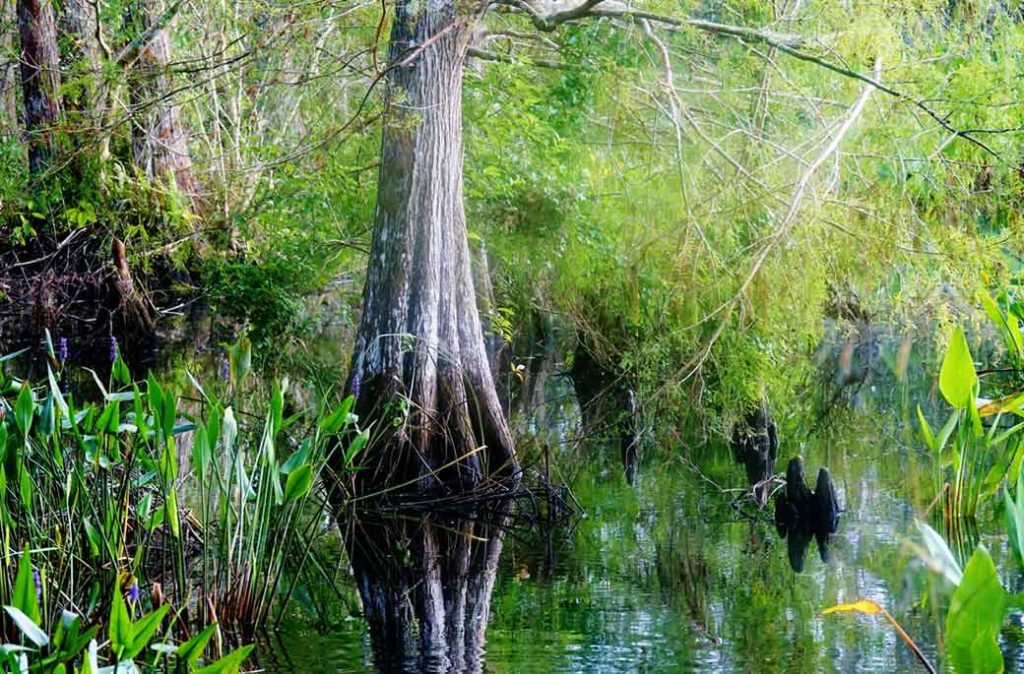by Patrick Higgins

Although the official economic impact assessment does not take into account the swamp’s non-recreational services, one of its greatest values is the tremendous biodiversity of plants and animals it supports.
If you asked a group of hikers sauntering along East Main through stands of towering native royal palms under a blue sky, or gently proceeding through the waters of a slough in dappled light – What’s the value of a swamp? – you would get very personal and deeply felt, almost spiritual answers. To us, as members of the Friends of Fakahatchee, they’re obvious and would just spill out.
First, there’s the joy and inner peace that any natural space generates, even if it’s just a well planted little corner of your yard. In fact, as I was typing this in front of my office window, I was willingly interrupted first by a soft-shelled turtle emerging from the undergrowth to cross into a lake on the other side of my road, looking silly with its massive 24-inch carapace and thick neck ending in a tiny snorkel nose.
A little later a hummingbird made a fleeting call on some coral bean blooming in a patch of sunlight in the woods, and after that the primeval head of a Knight anole peered around a tree trunk. Each time I rushed out with my camera, I felt the sun’s warmth on my back, breathed that earthy tropical Florida smell, and became distracted by something else in the garden. A half-hour easily passed each time – which is why it takes me so long to write these pieces – but back to the Fakahatchee.
There’s a special thrill about wild places – a feeling of discovery. Your senses are sharpened. You begin to notice smaller details. There are views into the depths of the swamp that are both beckoning and forbidding at the same time. And then there’s the knowledge that large predators are about, even if they are usually unseen and only evident from tracks, scat and tufts of fur – unless of course they are scaly. However, when one does have a chance encounter with a wild creature, there’s that momentary wondrous connection as you size each other up.
Sadly, much of our population has not had the time nor inspiration to experience the real Florida. To them, the sentiments above wouldn’t be convincing enough argument for the value of a swamp. With the exception of warm winters and palm trees, so many new residents want Florida to be just like up north, which is where the second part of FOF’s mission comes in – educating the public about the Fakahatchee’s ecology and its importance.
Wetlands deliver a wide range of ecosystems services apart from opportunities for recreation and tourism. They are reserves of water for our ever-growing population. They serve as flood controls. Without them rainfall would rush towards the ocean without any brake. Instead they slow down the water’s progress, acting like giant sponges, gradually releasing and cleansing it in the process.
Our swamp tree species sequester and store large quantities of carbon, helping to regulate our climate. And in our case, the Fakahatchee’s deep sloughs create a unique microclimate that allows tropical plants to flourish in its interior. Along the coastal portions of our park, mangroves serve as buffers against storms. In fact, the mangrove swamp and its trapped sediment and associated ecosystems can store as much as 10 times the amount of carbon as the same surface area of terrestrial forest, what is referred to as blue carbon.
However, one of the greatest values of wetlands are the plants and animals that make up their communities, and the tremendous biodiversity they support. This is certainly the case of the Fakahatchee, which is one of the most biologically rich regions of the greater Everglades ecosystem. We aren’t the orchid and bromeliad capital of the United States for nothing.
As guardians of this wonderful resource we need to be able to monetize this value as well, to convince the unbelievers. The state makes a pretty good first stab through its economic impact assessment for each park. Its 2016 assessment showed that visitors to the Fakahatchee supported 144 jobs in the area and contributed just over $9 million to the local economy. This will rise dramatically when our Big Cypress Bend Boardwalk expansion project is completed. We’re still expecting construction to start this year.
Unfortunately, our economic impact assessment does not take into account any of our park’s non-recreational ecosystem services. The state’s top 10 parks in terms of economic impact are all beach resources with high attendance. If the value of the Fakahatchee’s other ecosystem services could be factored in, the ranking would be flipped.
